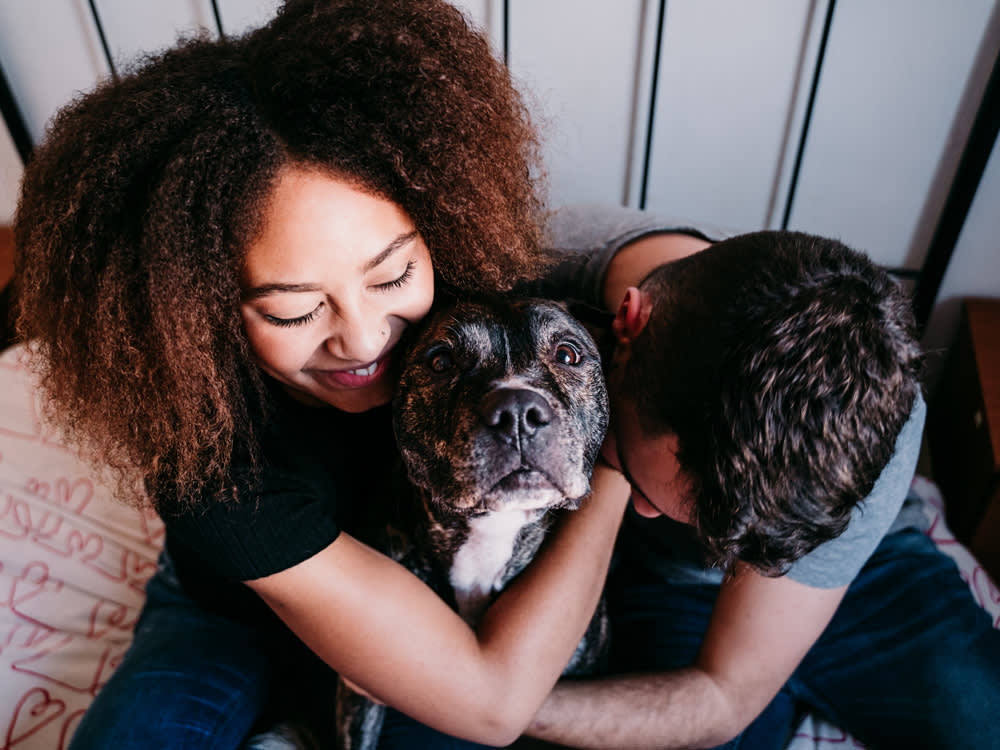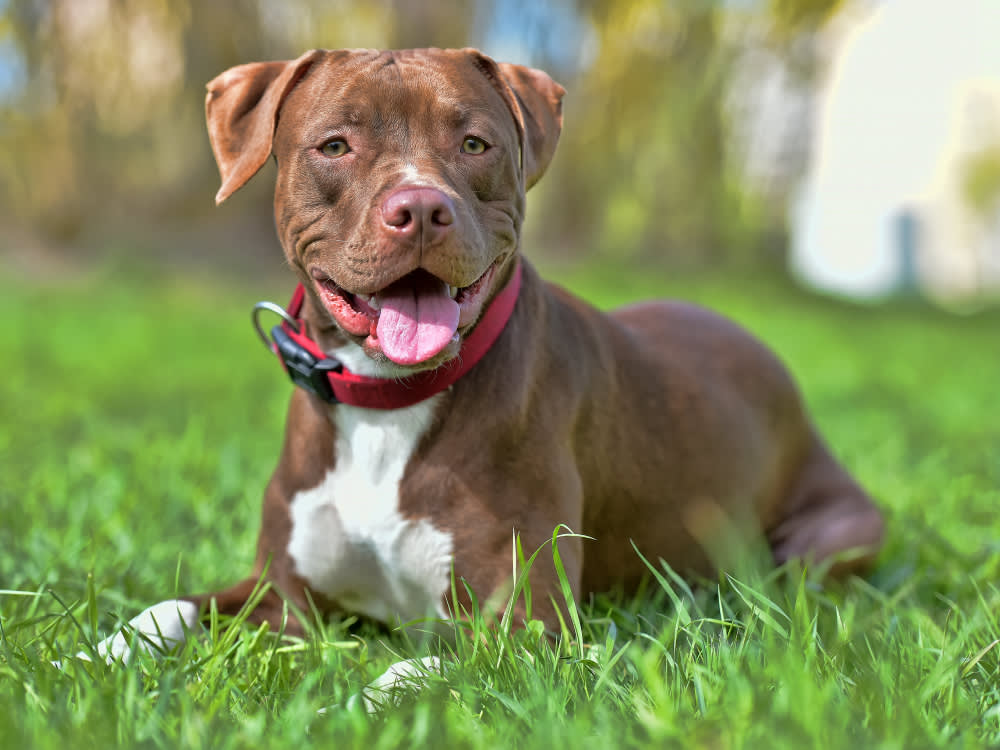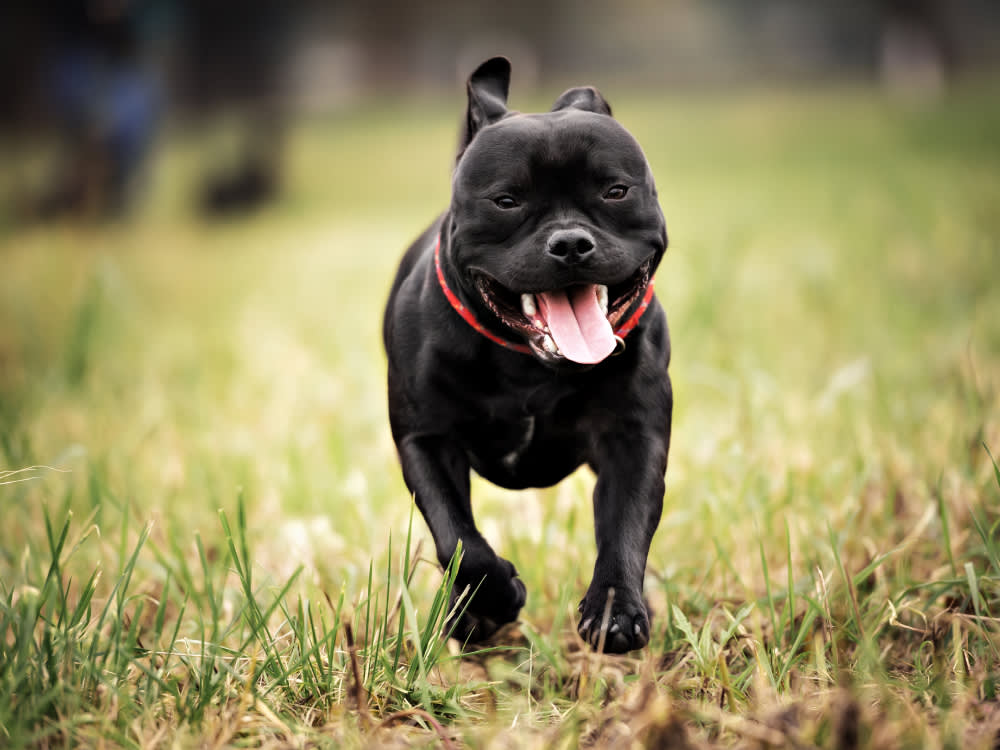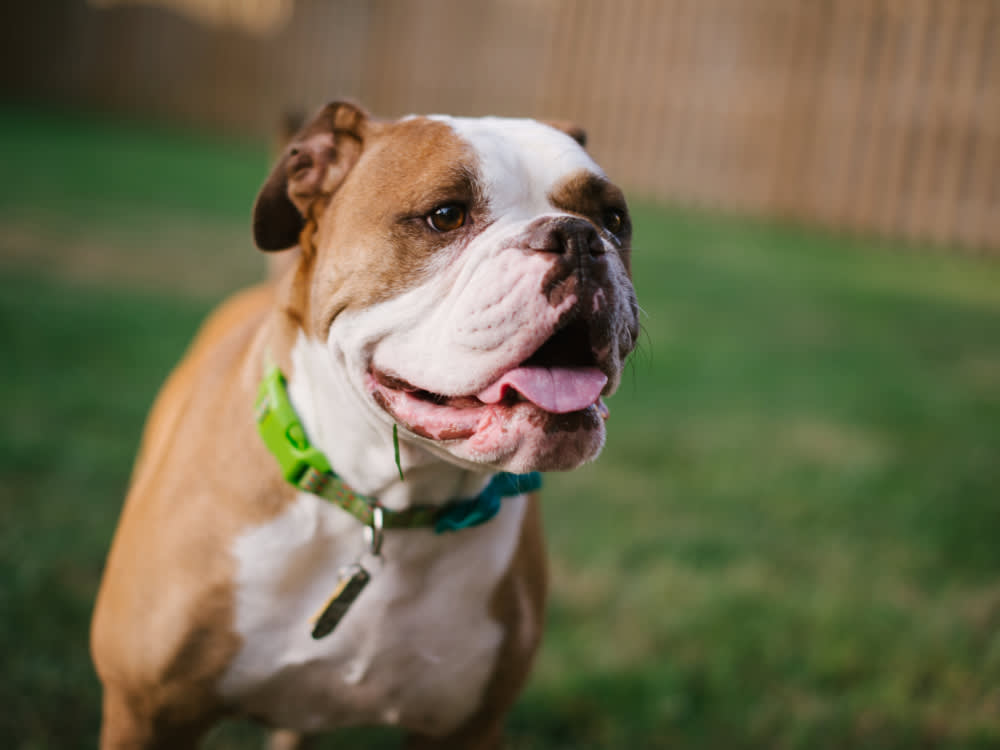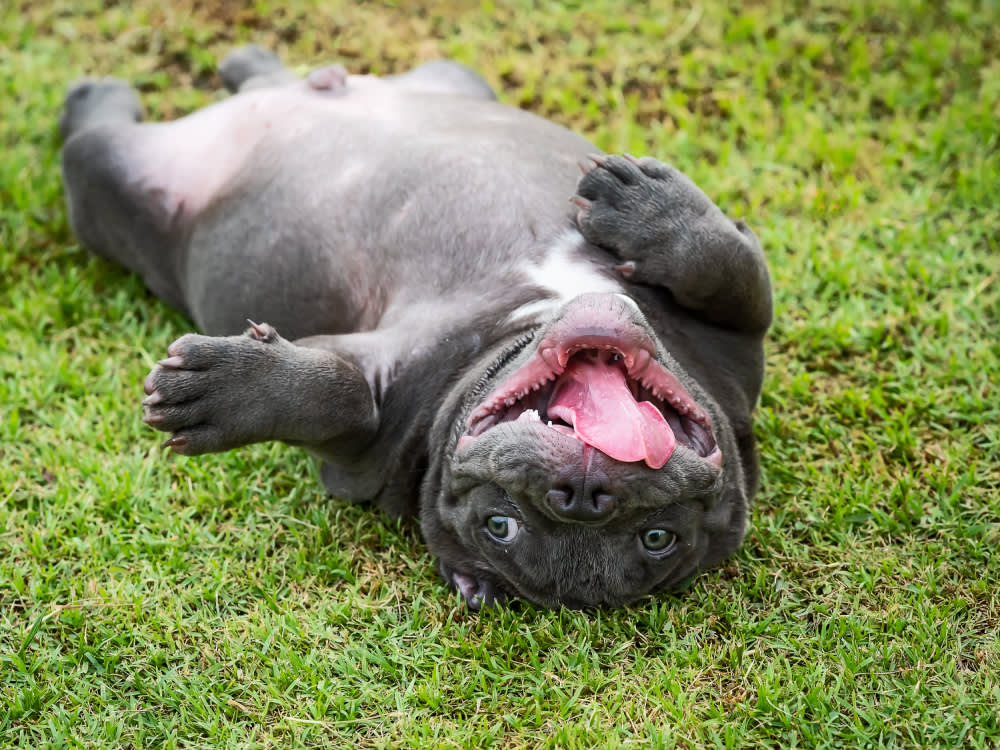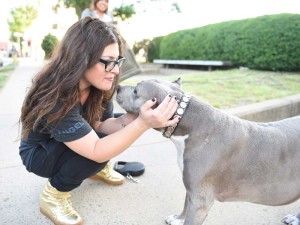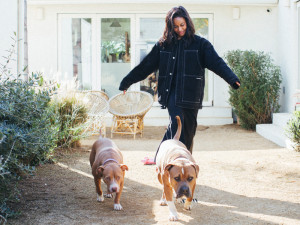What Is a Pit Bull, Exactly?
Everything you need to know about the five breeds dubbed “Pit Bulls.”
Whenever I’m walking my Pittie, Bansheeopens in new tab, two events are nearly guaranteed: No matter the time of day, someone will inevitably see us and quickly cross the street to avoid close contact with this perceived dangerous animal. Alternatively, a passerby will go out of their way to get closer. Do they have something to prove? Maybe. Time after time, strangers will approach and compliment her beauty, her gait, her muscular build. If you can think of it, they can praise it. They’re not wrong — she’s a dime.
But after each initial encounter, the conversation will inescapably evolve to a reflection on the awful situations many “Pit Bulls” find themselves in due to their unfortunate reputation. Both experiences —misunderstanding and passion — share one common misconception about the breed, or lack thereof. Officially, the Pit Bull doesn’t exist.
Okay, So WTH is a Pit Bull?
No, you did not just learn you’re in an alternate universe where Pit Bulls aren’t real, nor are you experiencing the Mandela Effect. Rather, this shared misconception is the result of many generations of random breeding and bad PR. The Animal Humane Societyopens in new tab (AHS) explains that the term Pit Bull doesn’t refer to a single breed; but rather, a group of breeds. Identifying any dog by appearance can be a bit dicey, but these particular pups are known for their muscular builds, blocky heads, and often shorter snouts (yes, all traits that can also describe multiple other breeds). Unfortunately, this flexible pool of identifiers has not been kind to the dogs’ public image. AHS notes that grouping so many dogs together under one label can skew statistics and contribute to harmful stereotypes.
While genetic traits play a role to a certain point (Border Collies are great at herding, Beagles are quick to pick up a trail), dogs — like people — are all different; and a dog’s personal history, living situation, training, and general treatment influences their behavior. The American Society for the Prevention of Cruelty to Animals (ASPCA) explained as much in their official statementopens in new tab on Pit Bulls:
How much do you spend on your pet per year?
“Physical abilities and behavior are both important facets of any breed. A well-bred dog should have both the physical attributes necessary to perform its job and the behavioral tendencies needed to learn it. However, while a dog’s genetics may predispose it to perform certain behaviors, tremendous behavioral variation exists among individuals of the same breed or breed type. The reality is that dogs of many breeds can be selectively bred or trained to develop aggressive traits. Therefore, responsible ownership of any dog requires a commitment to proper socialization, humane training, and conscientious supervision.”
The Breeds That Make Up a Pit Bull
Given the misinformation, misclassification, and general confusion associated with Pit Bull-type dogs, some of the specific breed attributes and features have become muddied over time. Clouding the field further, not even every Pit Bull-type pup is unanimously recognized as such. That being said, there are a few traits and common characteristics shared by the individual breeds that paint a decent picture.
American Pit Bull Terriers
American Pit Bull Terriersopens in new tab are known for their innate ability to form strong bonds with their families. They tend to have muscular builds; short coats; and can be black, white, brown, tan, or grey. Generally weighing between 30 and 65 pounds, these dogs are naturally loyal and affectionate. That said, some of them tend to have high prey drives. Banshee, for instance, will plow through any piece of furniture to get to her favorite ball. Strangely, American Pit Bull Terriers are recognized as a breed by the United Kennel Clubopens in new tab (UKC) yet not by the American Kennel Club (AKC).
American Staffordshire Terriers
Similarly, American Staffordshire Terriers, or “Staffies,” are intensely loyal and playful, while being a bit more mellow. Petey in The Little Rascalsopens in new tab was an American Staffordshire Terrier registered with the UKC as “Pal the Wonder Dog.” Despite often appearing indistinguishable from Pit Bull Terriers, Staffordshire Terriersopens in new tab are slighter larger, averaging around 40 to 70 pounds. They tend to be highly intelligent and confident, making them ideal candidates for training. Contrary to Pit Bull Terriers, Staffordshire Terriers are recognized as a breed by the AKCopens in new tab but not the UKC — a pointless club rivalry not seen since Barcelona vs Chelsea.
* Kinship recognizes both American Pit Bull Terriers and American Staffordshire Terriers for subscribers who sign up.
Staffordshire Bull Terriers
On the other end of the size spectrum, Staffordshire Bull Terriers produce smaller pitties, 24 to 38 pounds, who are gentle and patient. Though some can be prone to separation anxiety, in general these dogs are sweet-natured, well-behaved, and family-oriented, which explains their legacy as “nanny dogsopens in new tab” for kids in the 1900s. Of course, they’re also loyal and affectionate. Their coats are short and smooth, while their heads are distinctly larger, making them look kind of like bobbleheads. Two pairs of Staffy brothers in Australia — The Blue Boys Darren & Phillipopens in new tab and Ragnar & Lokiopens in new tab — are pretty popular on Instagram and great representatives for the lovable breed.
American Bulldog
The American Bulldog has a wide window on the scale front. At anywhere between 60 and 120 pounds, these pups have deeper chests and shorter muzzles. A descendant of the English Bulldog, these Pit Bull types are especially cuddly and known for loving to sit in laps despite their much larger-than-lap dog size. Similar to most pitties, American Bulldogs are pretty susceptible to allergies. And if you haven’t caught onto the trend yet, American Bulldogs are immensely loyal and affectionate.
American Bully
As the newest breed on this list, the American Bully was recognized by the UKCopens in new tab in 2013, but as of yet has not been recognized by the AKC. These dogs are super stocky and compact, running around 65 to 85 pounds. Sadly, they tend to be riddled with health issuesopens in new tab — from hip dysplasia to congenital heart failure to arthritis — stemming from generations of poor breeding (not unlike English Bulldogs).
Pit Bull History
Bronwen Dickey, author of Pit Bull: The Battle over an American Icon, traced the term’s first use to the 1800s. The label itself is a shortened version of the original term “pit bulldog,” which was used throughout the 19th century, Dickey told Todayopens in new tab. It referred to smaller, stocky, smooth-coated dogs that at the time were sadly used heavily in dog fighting. Pit Bulls are descendants of the original English Bulldog, a dog that was quite literally bred to bait bulls. As baiting animals became outlawed by way of the Cruelty to Animals Act in 1835, some turned to forcing their dogs to fight against each other. Despite this, many other Pit Bulls lived relatively low-key lives as farm dogs and family pets without incident. It’s a heartbreakingly polarizing pattern that has seemingly lingered for 200 years.
Conversely, around the turn of the 20th Century, Pit Bulls also quickly became known for their more genuine traits of playfulness, warmth, and caregiving — though it was far less publicized. Pit Bull-type dogs, particularly Staffordshire Bull Terriersopens in new tab, were nicknamed “The Nanny Dogopens in new tab” due to their excellence with children and proclivity to protect them. For generations in America and the U.K. Pit Bulls were viewed as the safest dog to leave with a child and the most reliable for all ages. Take one scroll through Pit Bulls of Instagramopens in new tab and you’ll see how these loving creatures haven’t changed much over the past 100 years — merely the perception of them.
Misrepresentation in the Media
Of course, as with so many other issues of long-term misunderstanding through misrepresentation, the media played a major role. Despite a heartful introduction to mainstream film and television with Petey in The Little Rascalsopens in new tab during the 1920s, Pit Bull portrayals in the media have often fed harmful stereotypes of their behavior. Frequently appearing as inherently vicious, the way these dogs were shown on-screen throughout the following decades would leave Petey remembered more for his circled eye than his breed.
Now, there has been a recent swift towards more positive cinematic portrayals of Pitties, highlighted by Keanu Reeves’ unnamed pupopens in new tab in the John Wick sequels — throughout which his dog is depicted as a loyal pacifist uninterested by the film’s increasingly violent world. It underscores a major theme of the movie: Pit Bulls, not inherently dangerous. Keanu Reeves, extremely dangerous, especially when armed with a pencilopens in new tab.
But the media’s largest contribution to Pit Bull misinformation came courtesy of everyone’s favorite supervillain ��— cable news. In 2007, when NFL quarterback Michael Vick was arrested for running a dog fighting ring, it ignited a storm of coverage and subsequent investigations into not only the player himself, but also the nature of these dogs. Many seized the opportunity to perpetuate bogus myths associated with the breed, such as them possessing “locking” jaws. *
Forty-seven dogsopens in new tab were rescued from Vick’s operation more than a decade ago, and while they’ve all since passed, a group of them became ambassadors for the breed. Dubbed the “Vicktory Dogs” and featured in the documentary Championsopens in new tab, their legacies could not be farther from their beginnings. They went on to be beloved pets, agility stars, and therapy dogsopens in new tab. One, Jonny Justiceopens in new tab, even participated in a library reading program for kids!
Pit Bull Facts
German Shepherds, Dobermans, Rottweilers, and Great Danes all have stronger bites than American Pit Bull Terriers.
In the American Temperament Test Societyopens in new tab rankings on dog temperament, both the American Staffordshire Terrier and the American Pit Bull Terrier earned high marks for affability, with scores of 90.9% and 87.4%, respectively. They are less likely to show aggression than Golden Retrievers, Border Collies, Poodles...the list goes on!
The media is biased against Pit Bulls when it comes to reporting dog attacks. To wit: In 2007, two dog attacks that occurred days apart received wildly different coverage. A senior man attacked by his Labrador Retriever and hospitalized in critical condition was covered in one local paper, while a woman bitten by her Pit Bull mix was covered by over 236 national and international news networks.
Where to Adopt a Pit Bull Mix
Not only are Pit Bull-type dogs the most common breeds in shelters (~50%), they are also the most euthanized. According to Save-a-Bull Rescueopens in new tab, of the roughly 1.2 million dogs euthanized annually, about 40% of them are Pit Bull mixes; plus about 75% of municipal shelters euthanize dogs that just look like them immediately upon intake, meaning they aren’t even given a chance. While you can find these breeds in every animal shelter in the US (so there is no excuse for buying one from a breeder) there are also many rescue organizations who have soft spots for them and are dedicated to finding them loving homes. Below are just a bunch to consider adopting from. You can also search for local pitties for adoption on Adopt-a-Petopens in new tab.
CA
LA Animal Servicesopens in new tab
Angel City Pit Bullsopens in new tab
Stand Up For Pitsopens in new tab
Pit Crew Sacramento Rescueopens in new tab
CO
Dumb Friends Leagueopens in new tab
GA
Fulton County Animal Servicesopens in new tab
IL
Peace for Pitsopens in new tab
LA
Villalobos Rescue Centeropens in new tab
MA
Pittie Love Rescueopens in new tab
ME
Pittie Posse Rescueopens in new tab
MN
Save-a-Bull Rescueopens in new tab
NY
Animal Care Centers of NYCopens in new tab
Sean Casey Animal Rescueopens in new tab
Second Chance Rescue NYCopens in new tab
Yonkers Animal Shelteropens in new tab
Brookhaven Town Animal Shelteropens in new tab
Town of Hempstead Animal Shelteropens in new tab
OR
Born Again Pit Bull Rescueopens in new tab
PA
Biggies Bulliesopens in new tab
TX
A PAWerful Rescueopens in new tab
In the meantime, feel no pressure to cross the street at a Pit Bull sighting, and while we welcome the compliments and proclamations, they’re certainly not required. Either way, we’ll be basking in the dog days living our best, slobbery, zoomies-filled life.
* Stay tuned for an article about Pit Bull facts vs. fiction.
